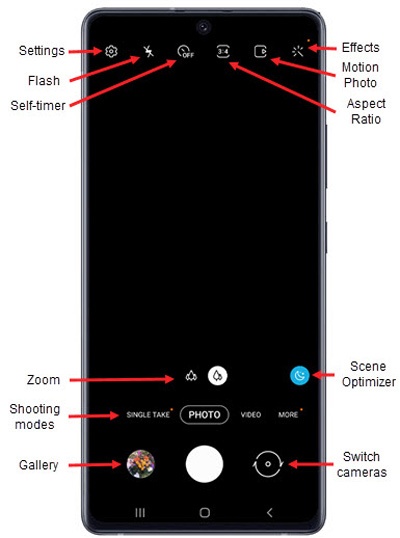Samsung released the Galaxy Note 20 Ultra 5G in August of 2020. The Note 20 Ultra has received great feedback from users all over the world.
We’ll look at the Note 20 Ultra features in 2023 in this article. The standard 20 features a 12-megapixel normal camera and a 64-megapixel 3x zoom telephoto camera, as well as the same ultra-wide camera.
Other interesting specifications of the camera include the ability to record 8K video, Pro mode (for both stills and video), raw capture, super slow-Mo video, HDR, and the ability to use the Stylus pen to control the camera.
General features include a 6.9-inch Quad HD+ Dynamic screen, a 4500mAh battery, wireless charging, 5G connectivity, 128GB of RAM, and either 256GB or 512GB of internal memory.
Ease of Use
The Samsung Galaxy Note 20 Ultra is available in three different colors – Mystic Bronze, Mystic Black, and Mystic White.
It’s incredibly gleaming and gives the phone a luxury appearance, but it’s best to have a case to protect it from scratches and bumps.
The camera unit on the back of the phone protrudes fairly far from the back of the phone, which means it won’t sit flat on a table, however, a case flattens out the back of the phone quite nicely, making it less unsteady.
The Note 20 Ultra, like the S20 Ultra, is a big phone. Because of their size, these super-large screen phones are referred to as “phablets”.
It’s wonderful for watching videos and looking at images, but holding and using the phone one-handed, especially when messaging, might be tough, especially if you have small hands.
The Samsung Galaxy Note 20 Ultra’s back.
By swiping up from the bottom right-hand corner of the lock screen, you may quickly open the native camera app.
The main camera app on the Samsung Galaxy Note 20 Ultra is pretty well-featured, as we’ve seen before, with a mix of automatic and more in-depth modes that should appeal to enthusiast photographers.
The program defaults to “Photo” mode, which is likely to be what you’ll use for the majority of your images. This is a rather simple model with a few alternatives to consider.
Three trees represent the ultra-wide-angle lens, two trees represent the standard, and a single tree represents the telephoto lens.
If you tap on any of these icons, you’ll go straight to that lens, but you’ll also see along the bottom options to choose other zoom ratios, ranging from 0.5x-50x. These will use a mixture of optical and digital zoom to achieve. You can also pinch to zoom on the screen if you prefer.
A picture-in-picture display will appear while utilizing the 50x zoom, allowing you to monitor the topic around the frame. This makes it much easier to properly frame your photograph.

Camera Settings

You’ll also see a row of icons along the top of the Samsung Galaxy Note 20 Ultra’s screen that controls several tasks.
You can also tap the general “settings” icon to get more advanced/in-depth settings like “Save options,” “back video size,” turning on video stabilization, turning on grid lines, and so on.
The ability to turn on “keep settings,” which means the app will launch in the mode/settings you last used it in, is a helpful feature.
Back to the main screen, the other icons include a flash icon (which you can set to on, off, or automatic), a timer (which can be set to 2, 5, or 10 seconds), switching on motion picture (where a short video clip is recorded alongside your still image), and aspect ratio (here you have options of 3:4, 9:16, 1:1, and “Full” – which takes advantage of the whole phone screen, as well as the 3:4 108-megapixel option).
Image Playback
The Samsung Galaxy Note 20 Ultra produces photographs at a resolution of 12 megapixels by default, but if you’re shooting something with great detail or believe you’ll want to crop later, you may select the higher resolution option below.
If you want to shoot in a different camera mode, then you can swipe right or left at the bottom of the screen.
To the left of the Photo mode, is “Single Take”, which we’ve seen on other Samsung phones before.
With this option, you move the phone around the scene in front of you and it will record lots of different pictures and videos in different aspect ratios, with filters added and so on. It’s a good way to get lots of different shots of a special occasion or interesting scene.
Image Quality
All of the sample images in this review were taken using the 12-megapixel JPEG setting, which gives an average image size of around 5Mb.
Given the performance of other recent Galaxy models, we had no concerns that the image quality from the Samsung Galaxy Note 20 Ultra would be superb.
Samsung has once again created a great smartphone for photographers who want to take good photos in a variety of situations.
Most people will use the standard “Photo” mode for most of their photographs, which works well for most types of shots.
With this mode, colors are vibrant and well saturated, with plenty of detail.
On the whole, images look best when you stick to viewing them on the screen of the Note 20 Ultra itself – if you examine closely on a larger computer screen, you will likely see some smoothing which is pretty typical of smartphone photography.
Overall, images have good, balanced exposure, with all-purpose metering producing good results.So, I hope you get some useful knowledge from this blog post. For more updates, you can visit our Alfalah Mobiles websites and if you need any help regarding phone repair you can call us today.
